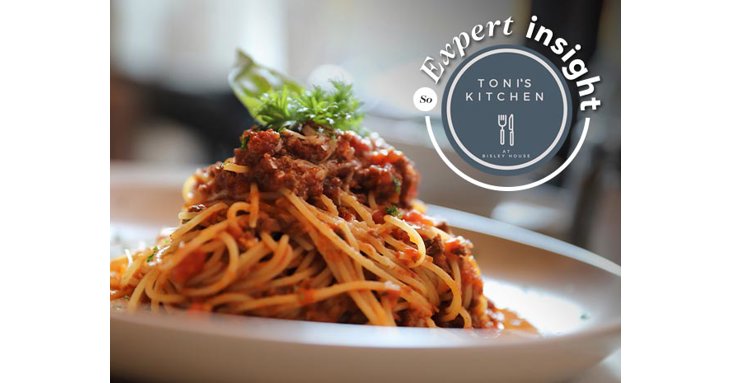Whether you love carbonara or are partial to a pomodoro, there’s nothing quite like a good pasta dish. But how can you bring the true taste of Italy to your kitchen? SoGlos speaks to Toni’s Kitchen to uncover the secrets behind the art of making pasta, and how to get your pasta sauce pairing just right.
About the expert – Toni’s Kitchen
Bringing the true taste of Italy to the Cotswolds, Toni’s Kitchen in Stroud is a family-run restaurant serving delicious food which combines simple Italian roots with French-style refinement. The restaurant opened after the success of Fat Toni’s pizzeria, and serves classic Italian dishes with modern twists. Using fresh, locally-sourced ingredients, Toni’s Kitchen uses 80 per cent of the plants grown in its garden within its innovative recipes.
Executive chef, Jason Orsi, known by some as ‘Toni’, specialises in the product development side of the business. Working as a chef since the age of 13, Jason moved to Italy at 17 years-old to learn the rustic style of true Italian cookery, using it to inspire the dishes he now serves at Toni’s Kitchen.
Read SoGlos’s review of Toni’s Kitchen to discover more about the delicious food.
For more information, visit toniskitchen.co.uk.
Is there a certain rule to abide by when pairing pasta shapes with different types of sauces?
Traditionally, you’d have your loose, long pastas paired with light or oil-based sauces like pesto or aglio olio e pepperoncino, which is oil, garlic, chilli and olive oil. Tubed pasta goes well with meaty or chunkier sauces. What we try and do is provide for both the English and Italian palette – it’s about finding that delicate balance.
Also, there are different grades of spaghetti. In England, there are one or two varieties of spaghetti, whereas in Italy I think there are 11 but only three or four are very common. People like the thinner spaghetti which is used for more delicate dishes like seafood spaghetti, and the thicker spaghetti such as bucatini, which has a hole down the middle, suits richer style sauces. Carbonara, amatriciana – any sauce that ends with ‘ana’ lend themselves well to denser pastas.
I’ve heard a rumour that spaghetti bolognese isn’t actually a traditional Italian dish! Is this true?
There are two great components to a spaghetti bolognese – the ragu, which they call ‘bolognese’ – whether or not that’s truly from bologna… it’s more the Emilia-Romagna area which Bologna is in – and spaghetti, which is a central to southern-Italian pasta. Traditionally, the two don’t really go well together, but everyone enjoys a bit of spag bol don’t they!
Should you salt the water when cooking pasta?
Yes, 100 per cent. A traditional pasta which is 100 per cent durum wheat is made from just flour and water. Adding a density of salt prevents the starch leaching from the pasta, so if you don’t put salt in your pasta you tend to get cloudier water. In scientific terms it’s osmosis; by adding salt, you’re diffusing it into the pasta, preventing too much of the starch leaching – this is essential for combining the sauces. Sauces are never ever added separately to the pasta – the pasta is always combined with the sauce.
How do you stop pasta from sticking together or to the pan?
You’ve got to make sure that the water is boiling. My grandmother used to use a handful of salt, or she said ‘it just has to be less seasoned than the ocean’! As long as the water’s boiling and you cook it for a minute or so less than the packaging recommends, it shouldn’t stick together. When you’re cooking dry pasta, you want it to be ‘al dente’, meaning you want a bit of bite to the pasta.
Are there different ways of making pasta from scratch?
Yes – there are different varieties of pasta. There’s egg pasta, which is normally made with 00 flour. The more north you go in Italy, the more egg yolk you’ll find with the flour, and the more egg yolk, the richer the pasta. The further south you go, the more durum wheat and water-based pasta you’ll find. So, if you’re making fresh pasta at home, you’re very likely to go for the more northern, luxurious recipe.
What advice would you give to a pasta-making newbie?
Never go cheap on the ingredients. If you’re going to make a meat-based sauce, it’s quite similar to when you make a curry – it’s better the day after when it’s been reheated and all the flavours have had time to marinade in the cooking. If you’re going to make bolognese, don’t cook it for 45 minutes, give it three or four hours.
Stop adding stuff – sometimes simplicity works. Some of the best pasta dishes in the world are pesto, carbonara, aglio olio e peperoncino – they’re all very simple. And they all dictate one thing: quality ingredients.
And don’t forget about quality parmesan – you can’t have good pasta without a bit of parmesan!
What’s your all-time favourite pasta dish?
On my honeymoon, we went to Italy and I ate spaghetti and seafood every day. So, I’d say spaghetti and clams is my favourite dish. It’s delicious.
For more information, visit toniskitchen.co.uk.
By Amy Wright















